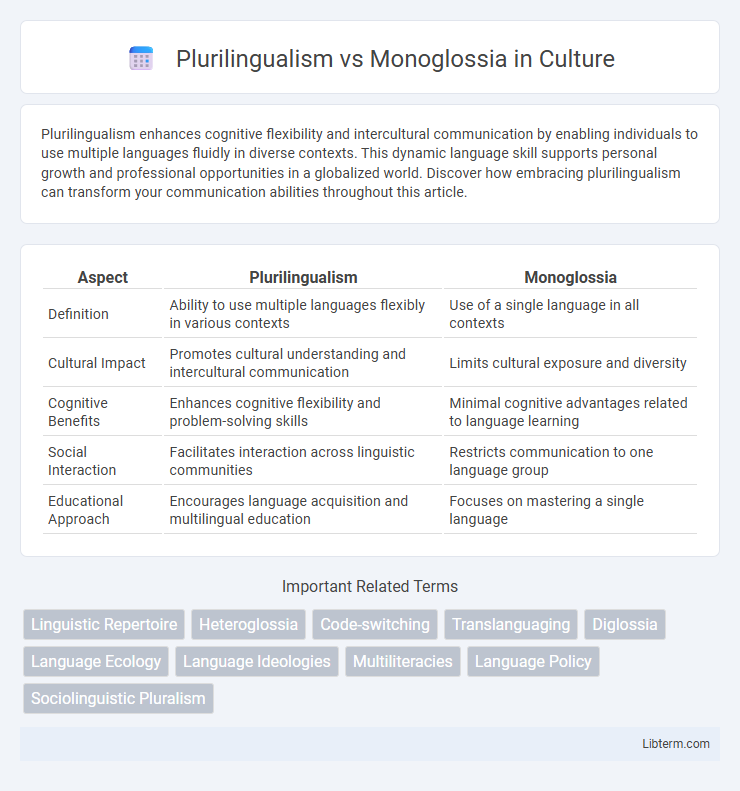Plurilingualism enhances cognitive flexibility and intercultural communication by enabling individuals to use multiple languages fluidly in diverse contexts. This dynamic language skill supports personal growth and professional opportunities in a globalized world. Discover how embracing plurilingualism can transform your communication abilities throughout this article.
Table of Comparison
| Aspect | Plurilingualism | Monoglossia |
|---|---|---|
| Definition | Ability to use multiple languages flexibly in various contexts | Use of a single language in all contexts |
| Cultural Impact | Promotes cultural understanding and intercultural communication | Limits cultural exposure and diversity |
| Cognitive Benefits | Enhances cognitive flexibility and problem-solving skills | Minimal cognitive advantages related to language learning |
| Social Interaction | Facilitates interaction across linguistic communities | Restricts communication to one language group |
| Educational Approach | Encourages language acquisition and multilingual education | Focuses on mastering a single language |
Introduction to Plurilingualism and Monoglossia
Plurilingualism refers to the ability of an individual to use multiple languages effectively, often blending linguistic resources to communicate across diverse contexts. Monoglossia describes a linguistic approach or mindset centered on the exclusive use or dominance of a single language within a community or individual. Understanding these concepts is crucial in fields like sociolinguistics and language education, where language policies and practices impact communication and identity.
Defining Plurilingualism: Beyond Multilingualism
Plurilingualism refers to the dynamic and integrated use of multiple languages by an individual, emphasizing fluid linguistic competence within diverse communicative contexts rather than the mere presence of several languages as in multilingualism. It highlights the cognitive and social ability to switch, blend, and negotiate meaning across languages, shaping identity and cultural understanding. Unlike monoglossia, which centers on the exclusive use of a single language, plurilingualism fosters linguistic flexibility and interaction, promoting a holistic language repertoire tailored to specific communicative needs.
Understanding Monoglossia: The One-Language Paradigm
Monoglossia refers to the one-language paradigm, where a single language dominates communication, education, and societal functions, often limiting linguistic diversity and individual multilingual potential. This approach prioritizes uniform language use, which can simplify language policies but may ignore the cognitive and cultural benefits associated with plurilingualism. Understanding monoglossia involves recognizing its role in shaping language identity while acknowledging its constraints in an increasingly globalized, multilingual world.
Cognitive Benefits of Plurilingualism
Plurilingualism significantly enhances cognitive flexibility, improving executive functions such as problem-solving, attention control, and multitasking. Unlike monoglossia, where only one language influences cognitive processing, plurilingual individuals benefit from increased neural plasticity and better memory retention due to constant switching between languages. Research shows that plurilingualism delays the onset of cognitive decline and strengthens metalinguistic awareness, leading to more effective communication and learning abilities.
Social and Cultural Impacts of Monoglossia
Monoglossia often leads to social exclusion and cultural homogenization by privileging a dominant language while marginalizing minority languages and their speakers. This linguistic uniformity can result in the erosion of cultural identity, reduced social cohesion, and limited access to education and economic opportunities for non-dominant language communities. The suppression of linguistic diversity undermines cultural heritage and diminishes the potential for intercultural dialogue and social integration.
Language Policy and Education: Plurilingual Approaches
Plurilingualism in language policy and education promotes the integration of multiple languages within curricula, fostering cognitive flexibility and cultural awareness among students. Educational frameworks adopting plurilingual approaches emphasize dynamic language use, encouraging learners to develop competence in several languages rather than mastering a single language, as seen in monoglossic models. These policies support inclusive practices, enhance communication skills, and prepare students for globalized contexts by recognizing linguistic diversity as an educational asset.
Identity Formation in Plurilingual vs Monoglossic Contexts
Plurilingualism fosters complex identity formation by enabling individuals to navigate and integrate multiple cultural and linguistic frameworks, enhancing cognitive flexibility and social adaptability. In contrast, monoglossic contexts often reinforce singular identity constructs tied to one dominant language, potentially limiting intercultural engagement and self-expression. The dynamic interplay between language competence and identity in plurilingual settings promotes a fluid, multifaceted sense of self distinct from the more fixed identity patterns observed in monoglossic environments.
Challenges and Misconceptions about Plurilingualism
Plurilingualism often faces misconceptions such as the belief that it causes confusion or hinders cognitive development, yet research shows that it enhances mental flexibility and problem-solving skills. Challenges include educational systems primarily designed for monoglossic instruction, leading to insufficient support for plurilingual learners and undervaluing their linguistic resources. Effective plurilingual education requires recognizing language diversity as an asset, fostering inclusive curricula, and training educators to address diverse language needs without bias toward monolingual norms.
Globalization and the Shift from Monoglossia
Globalization accelerates the shift from monoglossia to plurilingualism by demanding communication across diverse linguistic landscapes. Plurilingualism enhances cognitive flexibility and cultural competence, essential for navigating interconnected economies and multicultural societies. The dominance of a single language is increasingly impractical as businesses, education, and diplomacy rely on multilingual proficiency for global engagement.
Future Perspectives on Language Diversity
Future perspectives on language diversity highlight the growing importance of plurilingualism, which promotes cognitive flexibility, cultural awareness, and global communication skills. In contrast, monoglossia limits linguistic adaptability and reduces opportunities for cross-cultural exchange in an increasingly interconnected world. Embracing plurilingual education policies and multilingual digital technologies supports sustained language diversity and social inclusion.
Plurilingualism Infographic

 libterm.com
libterm.com